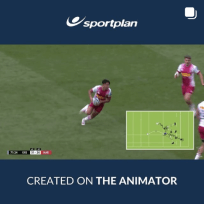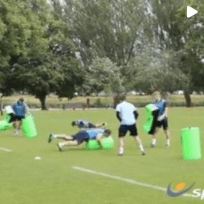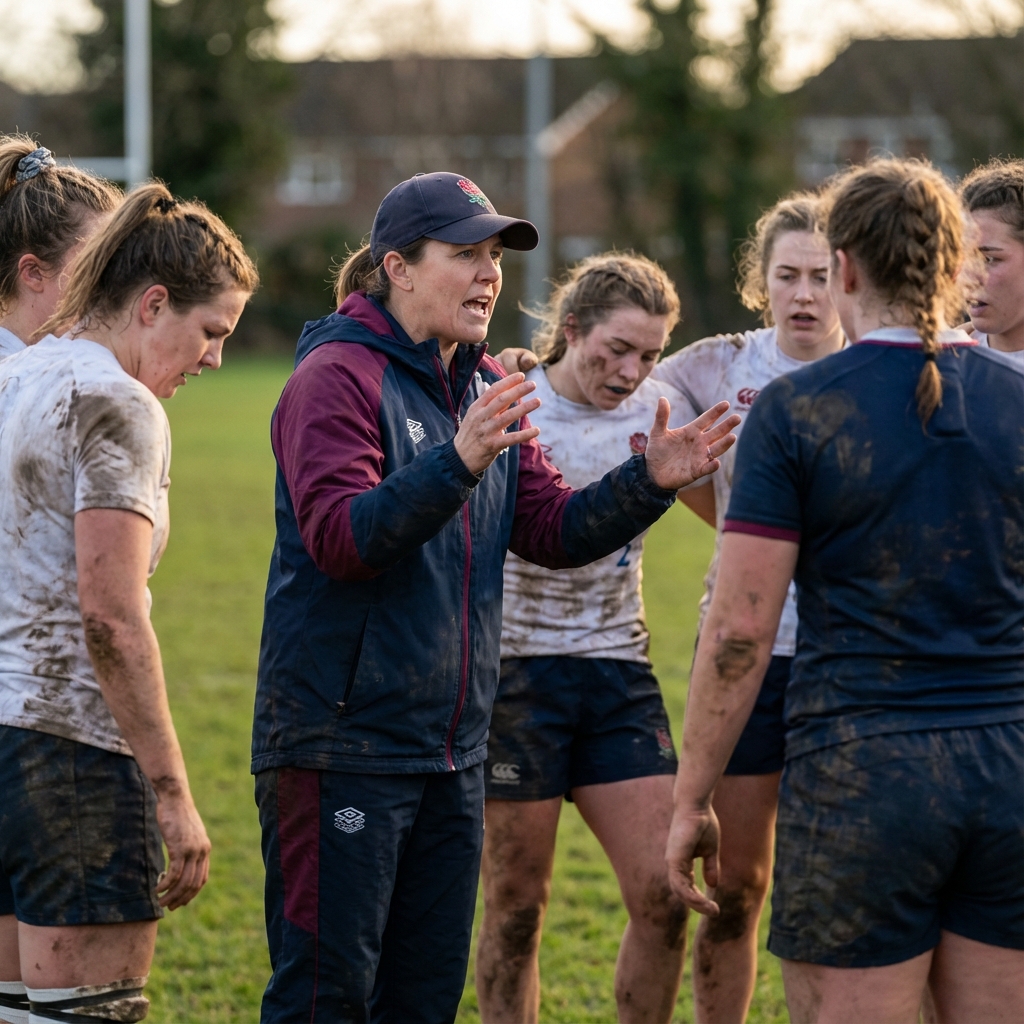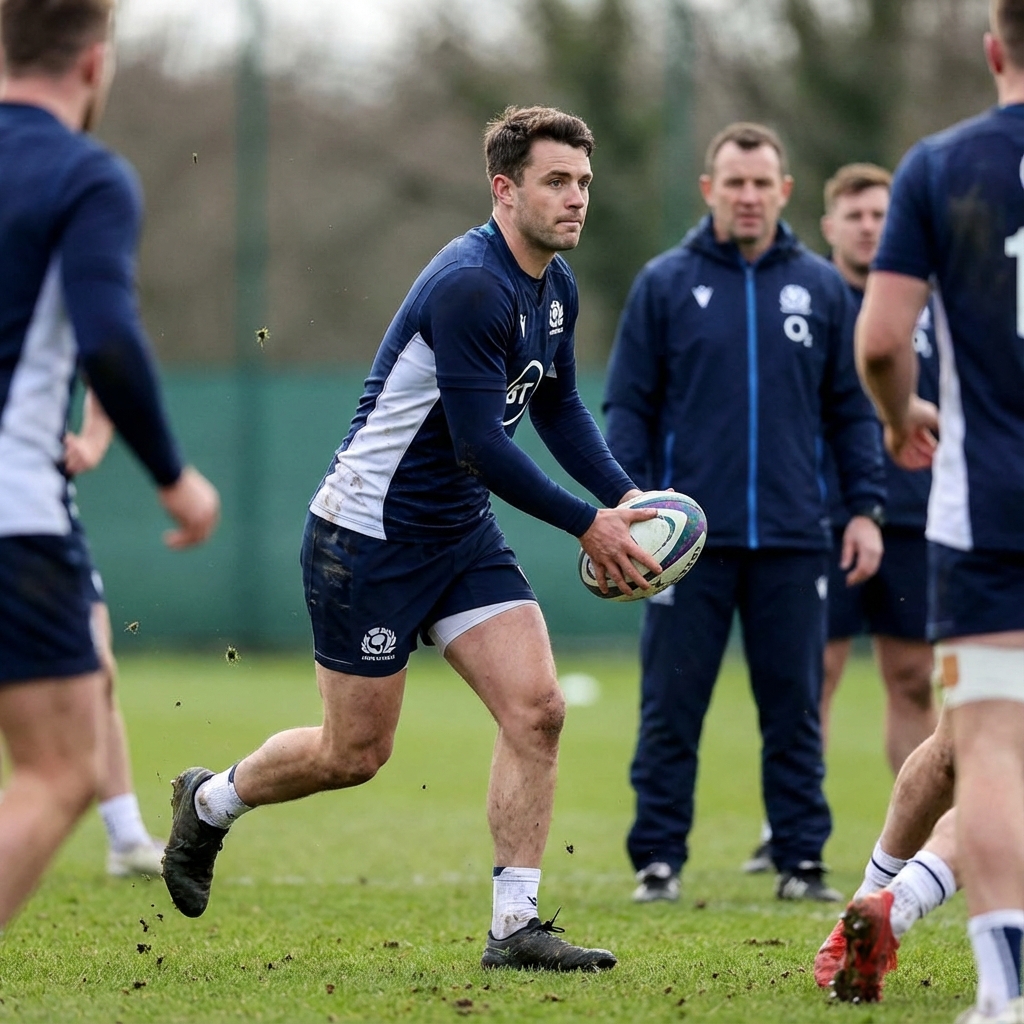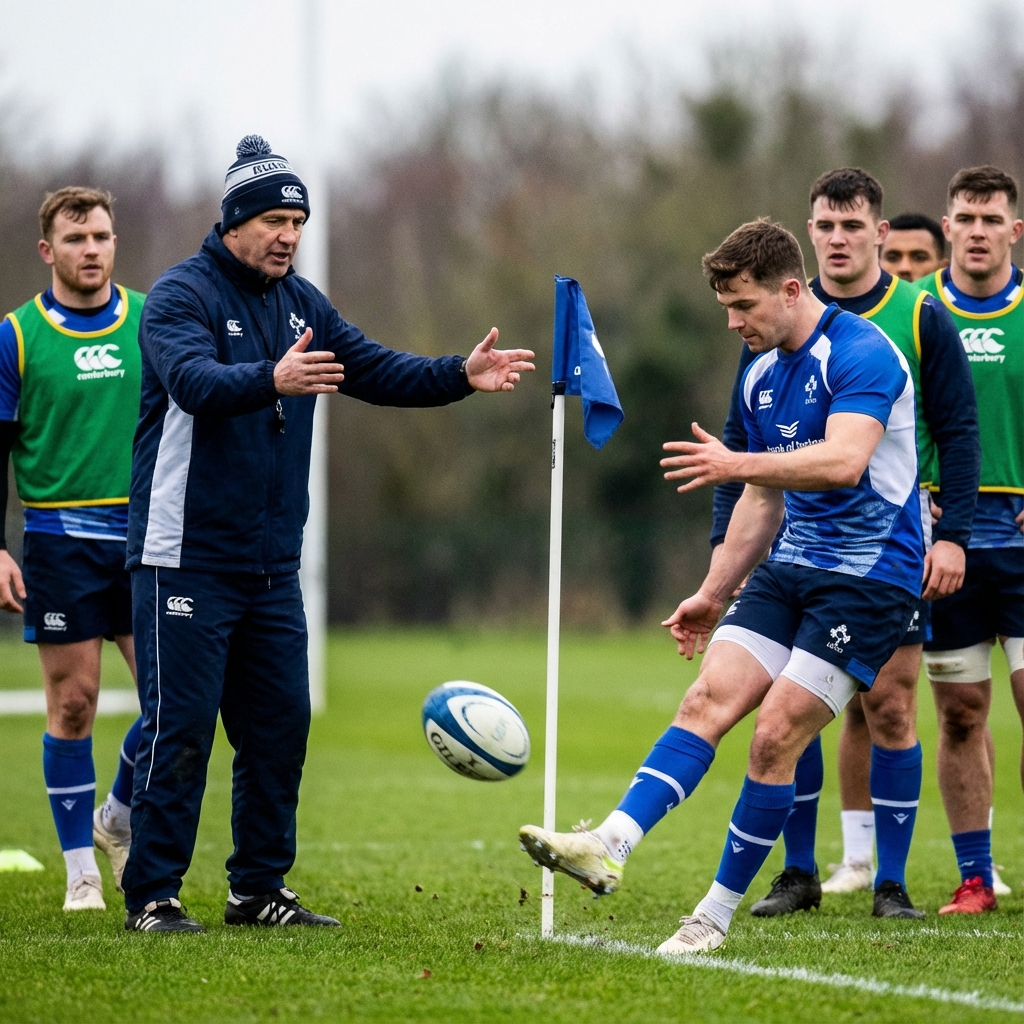switch pass in rugby union
switch pass in rugby union
Maria, I found this exercise in the passing section. Nick

Switch
DESCRIPTION
Switch
DESCRIPTION
From about U11 upwards I try to teach my backs the switch and dummy switch. Once you got a back line switching well, getting them to mix in the dummy switch, so the team mate makes the determined run inside but the pass isn't given keeps your opposite players on there toes and always thinking. I made this sketch - not sure if it is clear. I usually mix some sort of switching exercise towards the end of a passing warm-ups.

Dummy Switch
DESCRIPTION
Dummy Switch
DESCRIPTION
By playing more games.
Hi Everyone,
one thing is often neglected to mention (during game-situation) is the receiver should wait until he sees the ball carrier "cut" (or switch) towards him/her...then make the move in order to make the cut.
Many times I've seen the reciever cut way too early, then when the ball carrier looks for the switch theirs noone there.
Enjoy urselves! Psalms 27.
Hi,
take care with the cut as it is most effective when the "cutter" staightens their run directly to the goal line, the drills above make easy training drills but can teach ineffective game play
%3A)
There is a difference between a switch and a scissor....hence the 2 different names.
The first clip is a scissor and incorporates illegal action.
You cannot pass the ball to another player and that player carry the ball behind the first players back. You run the risk of being called for obstruction. Basic rule us that when the ball is being carried by a player it should be accesible to the other team. Now this is not to be confused with passing the ball behind a decoy runners back.
A scissor is what is being shown in the first clip. I havent viewed the second but it looks similar.
A switch is where instead of passing the ball 'down' the anticipated line, one passes the other way to someone coming off the inside shoulder.
Peter, in my view, the switch or scissor pass are both one and the same.
In my experience, one coach will call it a switch pass, one a scissor pass and one a cut pass, but the above clip is definately a switch/scissor/cut pass. I think its a matter of culture though, I hear most Southern Hemisphere coaches call it the 'cut' pass, British coaches will generally call it either a 'switch' or a 'scissor', and the French - 'changement'. Personally, I like to call it a 'cut' as scissor and switch are too 2-D. More scope to a cut, and a cut doesn't need to be made only by the ball carrier, support runners can also run a cut line as decoys.
In my view, the first clip above doesn't incorporate an illegal move, there is no 'blocking' of the ball. An illegal move would be 'crossing', which is what I believe you're getting at. Crossing is generally judged by the referee to be deliberate or accidental, but involves obstruction of the defence getting to the ball carrier. In the above clip, crossing would be where the ball carrier passes the ball to the support player at the cone, and then runs in front of the receiver at that angle.
Just to pick up on some of points. When the ball is being carried, it doesn't have to be accessible to the opposition, if it did, there'd be no maul, ruck, scrum or lineout. The pass behind is a miss, so long as its not passed to a player immediately behind the decoy runner.
Whatever its called, its an effective method of changing direction of attack and breaking the gain line. Aaron makes a great point about the 'cutter' straightening their run towards the goal line. It is so important to get players thinking about their angle of runs and how they can change them to make them more effective and then bring this into a 'switch/scissor/cut' pass practice.
Hello Dennis,
I haven't spent much time on this forum, and only noticed this question from an email but was intrigued. I was taught in UK in early 70's, yet I believe we have to find terms that can be easily called/expressed on the field and from which one will instantly recognize the obligations of all parties.
Maybe I should have defined switch vs scissor slightly different.
In a scissor the body moves outside shoulder to inside shoulder bringing the ball behind ones back and releasing to runner at the moment one has gone through at least180 degrees. If you will look at the clip again. The first run was Ok but the return run was clearly wrong. Ball carrier released the ball to the runner before he went behind his back. So, in effect the ball carrier was now blocking defence from reaching new runner with ball.
A switch is a perfect word for when one once again attempts to change direction but this time by movement of ball in front of body going back in the direction from where ball came.
We have 2 different words that efficiently describe the manner in which the ball will be distributed.
A cut could be anything.
THe law states;
A player must not intentionally move or stand in front of a team-mate carrying the ball, thereby preventing opponents from tackling the current ball-carrier or the opportunity to tackle potential ball-carriers when they gain possession.
Penalty%3A Penalty Kick
(c) Blocking the tackler. A player must not intentionally move or stand in a position that prevents an opponent from tackling a ball carrier.
Of course a maul is the only time a player with the ball may be behind a team mate....but then only when bound to his teammates.
Scrum is its own entity. Lineout however abides by this rule.
Ball is thrown in and both sides have equal access. One player catches. His team mates cannot stand in front of him.
And without seming pedantic, I would like to take umbrage with your last paragraph where you mentioned the gain line.
I take the view that this is not american football and the obsession with getting the ball past the imaginary line across the field from where the ball started is where, NH rugby in particular, we do a disservice to the game. The only gain line of importance is when one gets the ball behind the opposing player, in a manner where attacking team retains possession.
SH rugby is light years ahead of NH in the offload pass at the tackle, which could occur 20yds behind the gain line.Once through the defence in this fashion it is a foregone conclusion as to the end result.
Maybe a point for discussion?
Thanks Peter,
You're quite right, we do need terms that are easily identified by the players in our teams. So long as a coach is consistent in his/her jargon, then a problem shouldn't arise. It's only when we constantly change what jargon we use that we confuse. Think i'll stick with cut though, hasn't caused any problems thus far, and my players know what I mean!
My understanding of the laws of the game isn't that great, but in this day and age of the ELVs, whose understanding is. Even the refs are getting it wrong and the IRB are leaving it open to interpretation. However, I do understand about players blocking the ball carrier, but I think what you actually said was that the basic rule is that the ball must be accessible to the oppo at all times, which is what I responded to.
Without hijacking this thread, I think I will back up what I said about the gain line, and there is really only one gain line. It gives players an imaginary line to move the ball beyond, but also gives the defence a line to move beyond and make tackles. I take the line that if you don't look at getting the ball beyond the gain line at the next breakdown, whether it be from good lines of run or offloading in the tackle, then you will be constantly going backwards. So, using the gain line as a 'target', you aid players understanding of 'go forward'.
However, I agree with you about the offload in the tackle, and it is a big part of the game of teams I coach. I have to admit, i'm a continuity freak. What players do in the collision to keep the ball moving forward fascinates me and i'm constantly looking for ways to improve the offload, how players support and from where, and what they do when they receive the ball. If the ball is constantly offloaded within the pass receipt zone, it then becomes a lot easier to maintain go forward and play ahead of the breakdown.
One thing I find it important to establish is when we've called a 1st phase play, where the likely collision will be and from where, which I don't think is too difficult given how we can more or less predict how a drift/blitz will run. We then look at which oppo player will likely make the tackle. Once we've looked at these points, we then start to look lines of support and who will be the early support. We can pretty much predict the lines of support and who will be the next supporter with 2-4 offloads in contact within each phase of play. However, that said and done, I much prefer players look at whats in front of them and making decisions as play goes on.
When I mentioned the gain line above, I wasn't expecting discussion on it, however its always good to to take heed of others views. I don't disagree with what you've said.
In the above clip, the 2nd run does appear to be crossing, ball passed too early then a blocking run by the initial ball carrier. But in my experience, I very much doubt that a referee would pull this up and it would depend how far (width & depth) the receiver takes the ball, and again, that ALL important interpretation by the referee.
On the switch/scissor pass, being the sad old fellow I am, I took a look at my old RFU level 1 coursework folder, which shows visually a lateral, miss, loop and switch pass. The switch pass is shown with the ball being transferred behind the ball carrier and not moved around the front, which is shown in the loop. I asked the course tutor (Northampton saints academy coach) the other day what his view was on the difference between the switch and scissor was, and he said there isn't any.
When I started playing in the late 80's, I always remember it being called a scissors purely because of the angle of run the players took, but I very rarely hear it called that in the modern era. I always took it that scissors explained what the crossing lines looked like in plan view, but a switch is basically any pass used for transferring the ball to a player running a different line of attack, thus switching the direction of attack.
I would say though, that most coaches in England (or who I know for that matter), wouldn't coach a switch/scissor with the ball being transferred around the front of the carrier, as its seen as a deception move and if your dummy switching, its much more difficult to sell it to the oppo if its done in front than behind. A looping run and transfer of ball would be done in front of the ball carrier as he/she steps into the inside channel.
But as I always tell my players, 'there's no such thing as a wrong decision, only better ones!'. So long as the ball is contested for, is taken on with forward momentum, pressure is applied and continuity maintained, we'll score trys'!!!
Forgive me for my English, I am from Russia. I think it it will be simple for you. Look book "Think Rugby" Jim Greenwood. Page 137.138. You will not tell better.
On the issue of straightening the run of the receiver most exercises to teach switch or scissors are done with both players running at 45degrees. Once they understand the concept then the run of the passer should become much flatter and this allows the receiver to come on a line much nearer to straight.
Looking at the exercise using 4 players with the middle 2 switching/dummy, if you have the switch happening with 3 and 4 each time the ball goes along the line all 4 players are more involved.
I think the onus is on the ref's interpretation of the law as stated above, if the pass was initiated before the switch, its an offence of obstruction when in front of a man but if it happens after the swiitch there is no offence. I think you cen get away with it depending on the situation, if the pass becomes flatter and runner running 5-10 degrees However, if its a back flip pass to the switching player, I think there is no offence. I think its the way we interpret the law and how we go about and around it.
Perhaps some of you can help me out. I coach at the secondary school level in Canada and I was always taught as a player that when running a switch, both the passer and receiver cut at approximately a 45 degree angle with the receiver then straightening up their line towards the goal line after securing the pass. Recently, I saw another local coach teaching his players that the passer should cut sharply and the receiver more or less continues on their path straight up the field. Is this a more effective line of thinking about the switch. Which way should I be coaching my players? Any help would be appreciated.
Uhthoff,
In theory a switch is run at 45 degree angle when teaching the basics for players to learn the action. When applying it to a game like situation both players need to understand their roles. The ball players role is to move his defender and effectively open a hole for the receiver. It is important both players are moving forward and gaining an interest by defenders, playing a switch before the gain line is pointless.
In the diagram (not very user friendly, I apologise) you can see the ball carrier moving forward and then attempting to move his defender by running into the hole between defender 1 and 2. This will cause D1 to then turn his body and focus on the ball carrier. Meanwhile the receiver runs a switch hoping to find a hole inside of D1 or at the least catching a lazy arm or weak shoulder and allowing the receiver to get over the gain line.
Diagram








